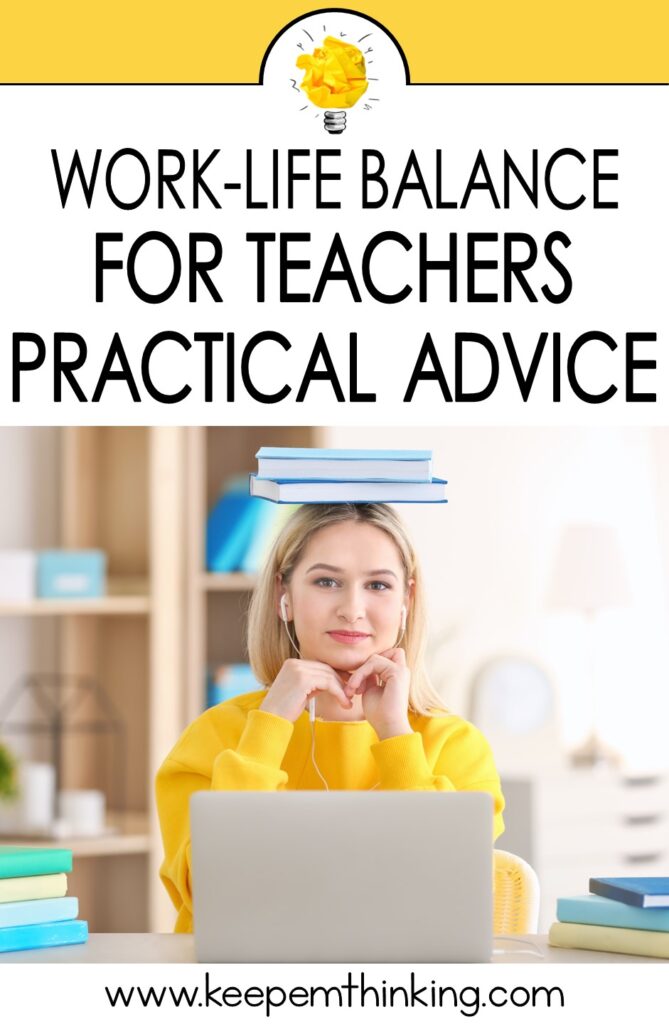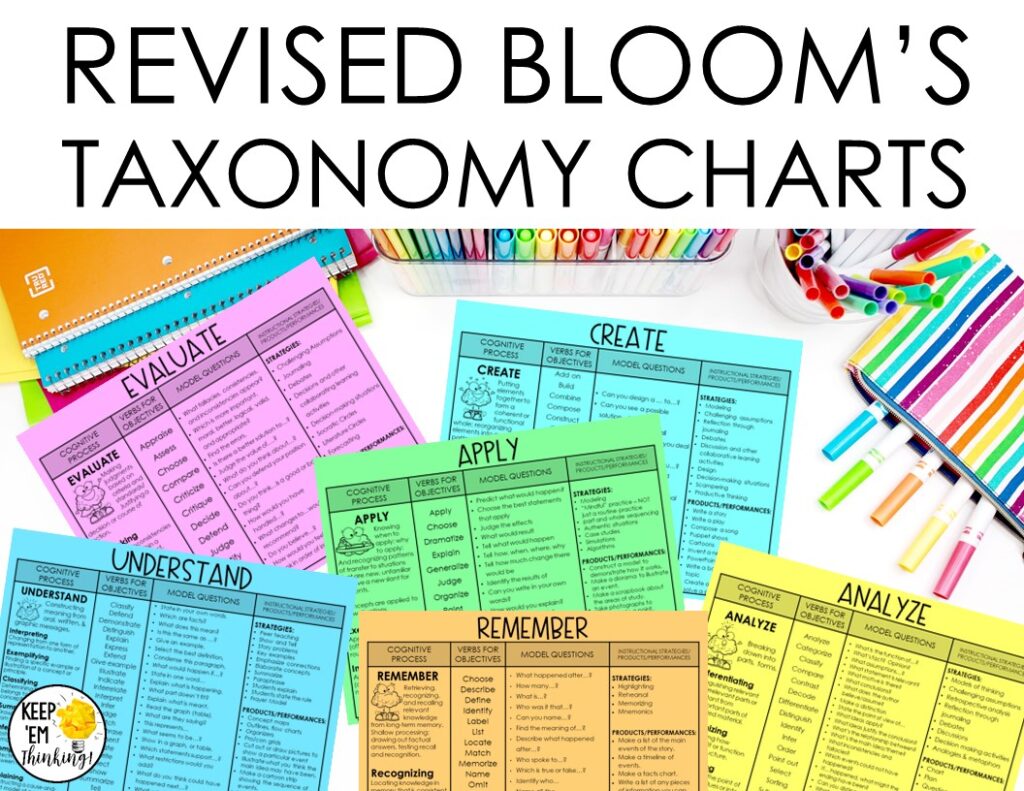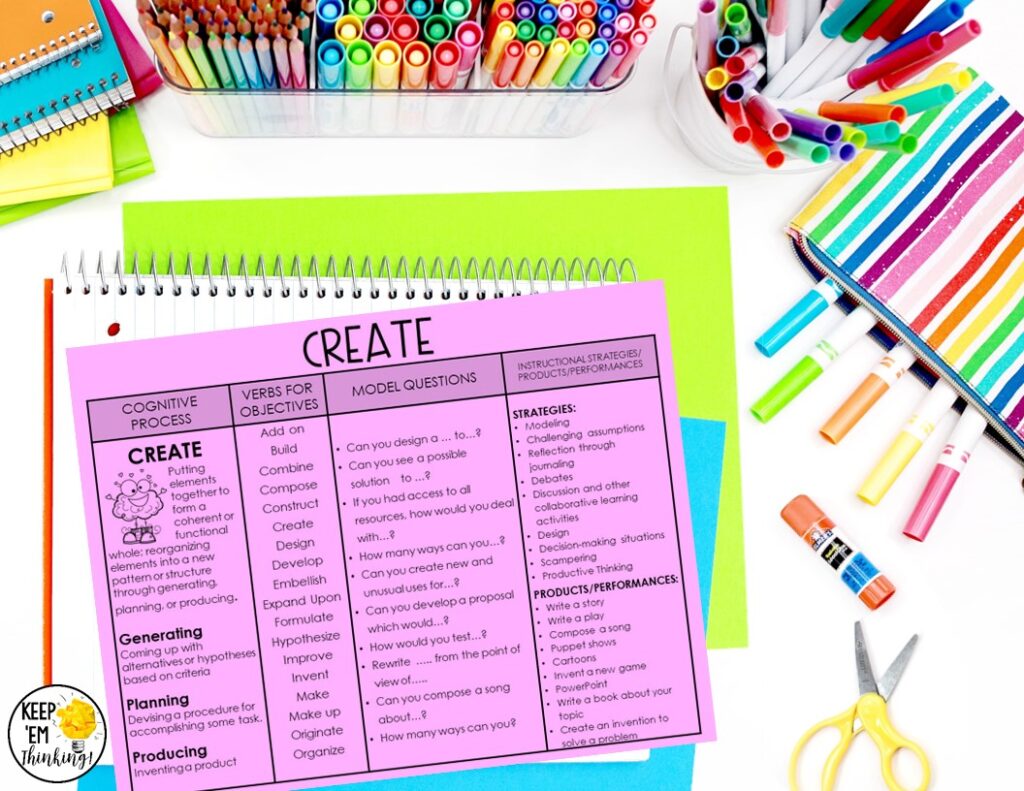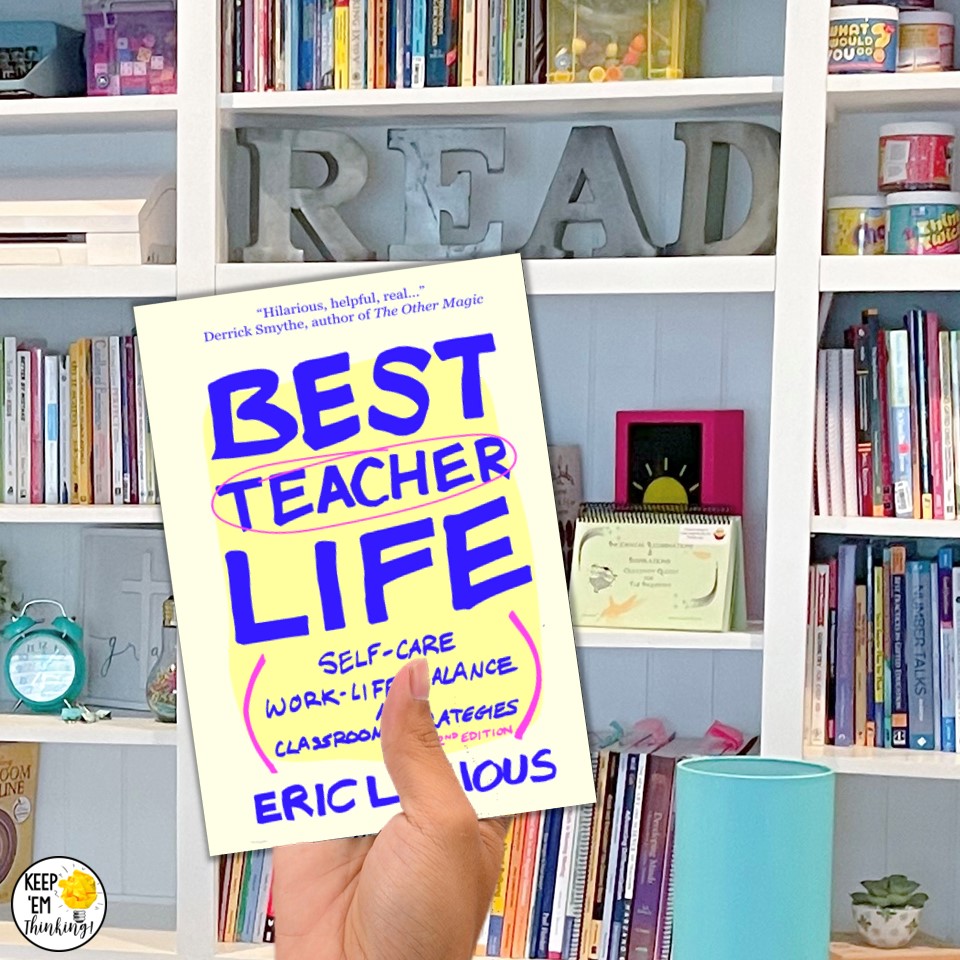Achieving a healthy work-life balance is more than just a trendy buzzword – it’s a necessity. Teaching is not just a job – it’s a passion, a calling. Between shaping young minds, planning lessons, grading assignments, communicating with parents, and fulfilling administrative duties, it can feel like a 24/7 commitment. But teachers, like everyone else, have lives outside the classroom.
Striking the right balance can help you maintain a high level of job satisfaction, reduce stress, and prevent burnout. This balance will ultimately lead to a healthier, happier you and more effective teaching. So, how can you find an equilibrium between your professional responsibilities and your personal life? Let’s discover some work-life balance tips to make our jobs as teachers and our personal lives more manageable.
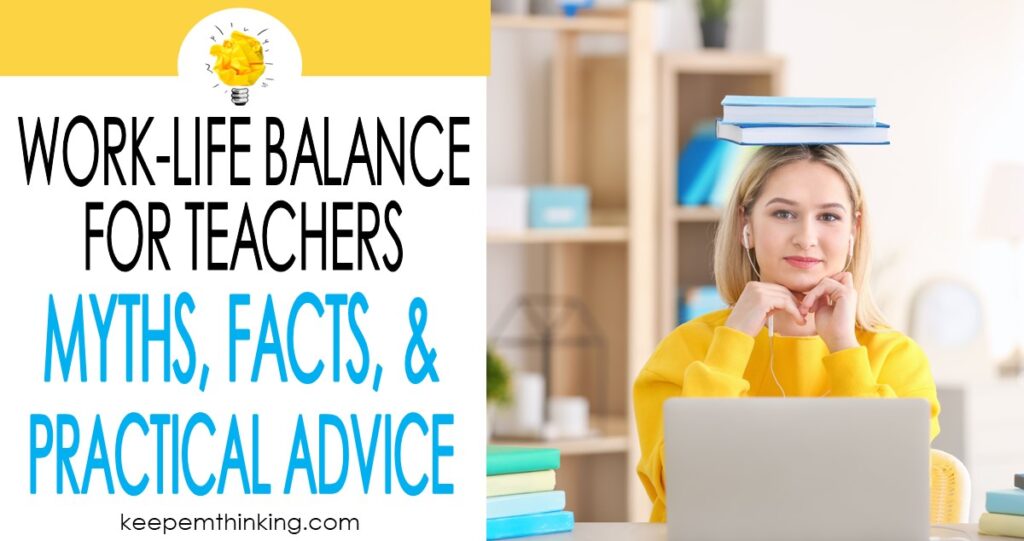

Myths about Work-Life Balance
The world of teaching, particularly in elementary education, is often misunderstood by those outside the profession. So, let’s uncover and debunk some of the most common myths.
Myth 1: The Job Ends When School Finishes

Many folks think a teacher’s work days ends as soon as the school bell rings. This couldn’t be further from the truth. Teaching extends beyond classroom hours. Lesson planning, grading assignments, organizing the classroom, and communicating with parents often spill over into teachers’ personal time. The result? A disruption in the balance between work and life.
Myth 2: Teachers Have a Lot of Free Time Due to Vacations
Yes, teachers do get longer breaks compared to some other professions. However, these so-called “vacations” aren’t always leisure time. Teachers use these periods to plan for the next term, attend professional development, or catch up on work that couldn’t be completed during term time.
Myth 3: Work-Life Balance is Only About Time Management
While time management is a critical part of work-life balance, it’s not the whole story. Striking a balance involves managing stress, setting personal boundaries, prioritizing tasks, maintaining physical and mental well-being, and fostering fulfilling relationships both inside and outside of work. Work-life balance is not just time division. It’s more complicated than that.
What Should We Do?
By debunking these myths, we can get a clearer picture of the challenges faced by elementary teachers in maintaining a healthy work-life balance. Recognizing these truths is the first step toward finding practical solutions.

Facts about Work-Life Balance in Elementary Teaching
Fact 1: Teaching is Often a Round-The-Clock Job

Teaching extends far beyond the traditional school day. Tasks like lesson planning, grading, parental communication, and attending extracurricular events often stretch into early mornings, evenings, and weekends. Because this commitment blurs the boundary between work and personal life, it is hard to maintain balance.
Fact 2: Teaching is Stressful and Emotionally Demanding

Teaching isn’t just about delivering academic content. It’s an emotionally demanding job that involves managing classroom behavior, supporting students’ emotional well-being, and dealing with various stressful situations. This emotional labor can take a toll on a teacher’s mental health. Therefore, if they are not managed properly, they will negatively impact your work-life balance.
Fact 3: Summer Vacations do not Necessarily Mean Leisure Time

Contrary to popular belief, vacations for teachers aren’t always leisure-filled breaks. Many of you spend your “off” months attending workshops and other professional development activities, plus planning for the next year.
Fact 4: Work-Life Balance is a Complex Construct Involving Several Dimensions
A healthy work-life balance isn’t just about how you spend your time but also how you manage your physical, emotional, and social well-being. It’s about being able to detach from work, engage in stimulating activities, and maintain satisfying relationships. Achieving this balance requires conscious effort and smart strategies.

Why is a Good Work-Life Balance Important?
Let’s discuss the potential negative outcomes of poor work-life balance on teachers’ professional and personal lives.

Burnout and Its Symptoms
Burnout is a state of chronic physical and emotional exhaustion, often accompanied by feelings of cynicism and detachment. It is a serious issue in teaching. It is often caused by excessive workload, stress, and a perceived lack of control. Symptoms can include fatigue, insomnia, poor concentration, and even physical symptoms like headaches or stomach issues.
Effect on Teaching Quality and Student Outcomes
Teachers who are stressed or burned out are less likely to be effective in the classroom. They may struggle to engage with students, plan creative lessons, or maintain a positive classroom environment. This could negatively affect students’ academic outcomes and their overall learning experience.
Impact on Personal Life and Relationships

When work consistently spills over into personal life, relationships, and personal commitments may suffer. Teachers may find they have less time for their families, friends, or hobbies. Over time, this can lead to feelings of frustration, dissatisfaction, and even isolation.

Practical Advice for Achieving Better Work-Life Balance
Recognizing the importance of work-life balance is just the first step. The real challenge lies in putting that into practice. Let’s look at some strategies you can implement today to help you create a healthier life.
Tips for Effective Time Management
Prioritizing Tasks: Not all tasks are created equal. Distinguish between what's urgent and important. Plan your day around your highest priority tasks, and try to delegate or eliminate non-essential tasks.
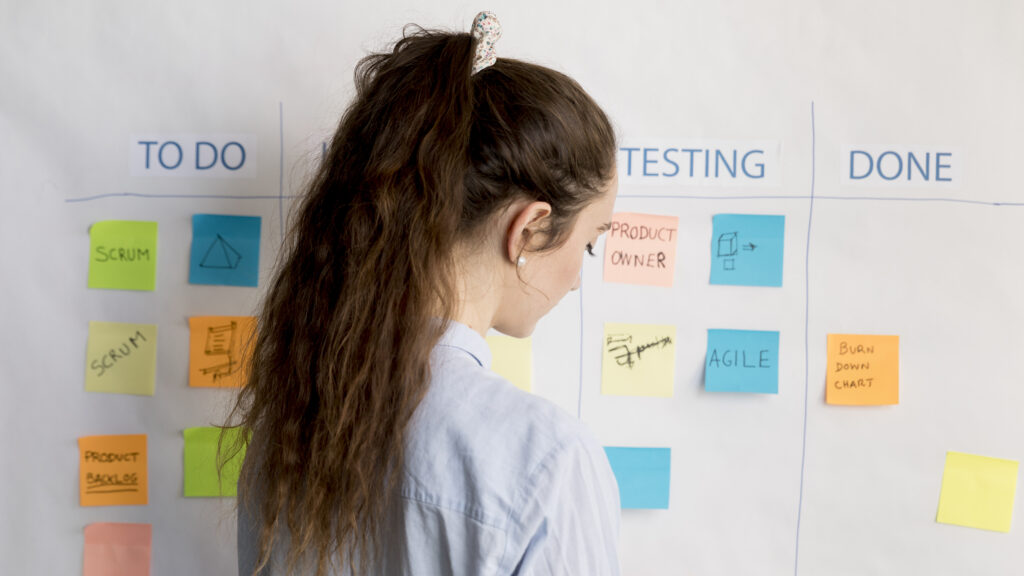
- Jessica’s Prioritizing Tasks Routine: Jessica tries to distinguish between what’s urgent and important. She then plans her day around the highest priority tasks, and tries to delegate or eliminate non-essential tasks.
- Emma’s “Task Batching” Approach: Emma, a third-grade teacher, groups similar tasks together to increase efficiency. For example, she schedules a specific time for grading papers, a time for parent communications, and a time for lesson planning. This approach minimizes the mental load of switching between tasks, making her more productive and freeing up more personal time.
- Susan’s Strategies Checklist: These Bloom’s Taxonomy charts were real handy when I create lesson plans. They include verbs to use, model questions, strategies, and products and performances for each level of Bloom’s. They save ton of time when planning ways to differentiate for the kids in your classroom. You can find them in The Teacher’s Toolbox, my FREE Resource Library.
Setting Boundaries: Have a clear division between your work time and personal time. As far as possible, try not to bring work home. If you must, designate specific times for work-related tasks and stick to them.

- Daphne’s Power Hour Routine: As far as possible, Daphne tries not to bring work home. She uses the ‘power hour’ strategy, dedicating an hour after school to complete as many tasks as possible. This leaves the rest of her evening free for personal time.
- Daniel’s “End of Day Reflection” Practice: Daniel, a fifth-grade teacher, ends each workday by jotting down what went well and what could be improved. This helps him track his progress, learn from his experiences, and separate his work life from his home life. You can check out this blog post for some tips about teacher reflection and a free teacher reflection worksheet.
- James’ “Preparation Sunday” Technique: James, a fourth-grade teacher, spends a few hours each Sunday preparing for the week ahead. He plans his lessons, organizes materials, and answers emails. This helps him start each week with a clear mind frees up more time for personal activities.
- Rachel’s “Digital Downtime” Approach: Rachel, a second-grade teacher, sets a rule for herself to turn off all work-related electronic devices after 7 PM. This digital downtime allows her to fully disconnect from work and spend quality time with her family each evening.
Using Technology to Save Time: Utilize technology tools for lesson planning, grading, communication, and more. These can save you significant amounts of time and reduce your workload.

- Adam’s Computer Software Approach: Adam, a sixth-grade teacher, uses project management and productivity software to streamline his administrative tasks. This frees up more of his time to focus on teaching and personal pursuits. Utilizing technology tools for lesson planning, grading, communication, etc. can save you significant amounts of time and reduce your workload.
- Melissa’s Template Approach: Melissa creates templates for assignments, newsletters, lesson plans, and emails to quickly duplicate activities and messages she uses frequently.
- Bethany’s Digital Calendar Strategy– Bethany uses digital calendars to block off time to get tasks accomplished and uses the reminder features to alert her when it is time to start a task.
Strategies for Managing Stress
Regular Exercise and Healthy Eating: Physical health significantly affects your mental well-being. Make sure to include regular exercise in your routine, and maintain a balanced diet to keep your energy levels stable.
- Sophie’s “Fitness First” Strategy: Sophie, a second-grade teacher, always starts her day with a morning workout. This routine energizes her for the day ahead and ensures that she gets her exercise in, even if her schedule becomes hectic.

Mindfulness and Meditation: Practices like yoga, meditation, or simply spending a few minutes each day in silence can help reduce stress and promote a sense of calm.
- Emily’s “Mindful Mornings” Routine: Emily, a fourth-grade teacher, starts her day with a 15-minute meditation. This helps her to center herself and approach her day with calmness and clarity.

- Julia’s “Morning Pages” Ritual: Julia, a first-grade teacher, begins each day by writing in her journal. This practice helps clear her mind, manage stress, and set positive intentions for the day. You can get a free Morning Journal for Teachers by clicking on the picture below.

- Nina’s “Daily Gratitude” Practice: Nina, a first-grade teacher, ends each day by writing down three things she is grateful for. This practice helps her maintain a positive mindset, focus on the good aspects of her job, and separate work-related stress from her personal well-being.
Seeking Professional Help When Necessary: If stress and anxiety become overwhelming, don't hesitate to seek help from a professional counselor or therapist.
- Janet’s Counseling Connection Journey: When Janet experienced overwhelming stress and anxiety, she recognized the need for professional intervention. She sought the help of a therapist specializing in stress management. Through therapy, she learned techniques to manage her stress effectively. Her openness about her therapy journey also fostered a healthier dialogue about mental health in her school community.

Building and Maintaining a Support Network
Connecting with Colleagues: Your fellow teachers can be a great source of comfort, advice, and support. They are likely facing similar challenges and can provide useful perspectives and solutions.

- Lily’s “Teaching Buddy” System: Lily, a kindergarten teacher, collaborates closely with another teacher in her grade. They share lesson planning which lessons the workload for both.
- Sophia’s “Teacher’s Book Club” Method: Sophia, a second-grade teacher, started a book club with her colleagues. They meet weekly to discuss a book related to personal development, education, or just for fun. This provides a stress-relieving social activity and a chance to learn from each other.
Finding Mentors: A mentor can provide guidance, support, and share their experiences in managing work life balance.

- William’s “Learning Lunches” Method: Once a week, William, a fourth-grade teacher, has lunch with different colleagues to exchange ideas, share experiences, and learn from each other. It allows him to grow professionally and personally without intruding on his out-of-school time.
The Importance of Personal Time and Self-Care
Pursuing Hobbies and Interests: Engaging in activities that you love can help relax your mind and provide a necessary break from work.
- Sam’s “Midweek Break” Method: Sam, a third-grade teacher, sets aside Wednesday evenings as his “mini weekend.” He works on a hobby, goes out with friends, or just relaxes at home. This gives him a much-needed break in the middle of the week.

- Chloe’s “Outdoor Time” Strategy: Chloe, a third-grade teacher, takes a daily after-school walk in nature. This gives her time to unwind, disconnect from technology, and enjoy a much-needed change of scenery.
Making Time for Family and Friends: Relationships are vital for emotional well-being. Make sure to carve out quality time with loved ones.
- Leo’s “No-Work Weekends” Rule: Leo makes a strict rule for himself that weekends are completely free from work. He spends his weekend doing things he enjoys or spending time with family and friends. He is recharged when the new week begins.

- Lucas’ “Family First Fridays” Plan: Lucas earmarks Friday evenings for family activities. It may be a movie night, board games, or going out for dinner.
Understanding and Enforcing Personal Boundaries: Learn to say 'no' when necessary. It's important to protect your personal time from encroachments of professional commitments.

- Charlotte’s Polite Refusal Policy: Charlotte realized that additional school commitments were taking away her personal time. She politely refused to take on tasks she wasn’t interested in and began experiencing less stress.

Final Thoughts
By implementing these strategies, you can achieve a healthier work life balance. For more strategies and tips for self-care, you can check out the book Best Teacher Life on Amazon.
Remember, it’s essential to listen to your own needs and to realize that maintaining a work-life balance isn’t a sign of weakness or lack of commitment. The journey towards work-life balance is a personal one, and there is no one-size-fits-all strategy. Experiment with different techniques and find out what works best for you.

Pin For Later
